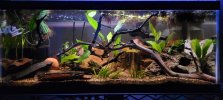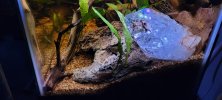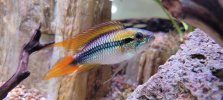saturniidae
New Member
- Messages
- 2
Hello folks!
I'm new to apistogramma, and I suppose I'm still new to fishkeeping in general. Last April I dove into keeping neocaridina shrimp, got a serious case of Multiple Tank Syndrome, and well... let's just say I work at my local fish store now haha (Seriously, props to my LFS owner & boss for putting up with me.)
When I set up my 20gal long, I made the same mistake a lot of new users here make: I conflated community tanks with breeding tanks. I saw apistogramma commonly listed as popular "centerpiece" fish for community tanks, and read that a 20gal was perfect for a pair. I stuck 8 rummynose tetras and 6 pygmy cories in my tank and set out to find my dream fish.
I found the pair I was looking for last week - A. agassizii, from a local hobbyist. (They were sold to me as "triple red" but... I think they're double red? Does triple even exist in agassizii? Whatever they are, I think they're both stunning!) I brought them home, drip-lined them for a nice long time, and added them to the tank.
Then I started reading apisto-specific advice instead of generalist advice, and realized I'd made some mistakes. I'd tried to get the best of both (breeding and community) worlds, and was likely stressing my fish out. I decided to focus on the pair as a breeding project, transferred the cories to a different tank, and traded in the rummynose tetras (already beyond frustrated by their seemingly random deaths). I removed the Penguin 200 in favor of a sponge filter, and added some floating watermoss. I added an apisto hut and a betta hide, on top of the cave rock I'd already provided. I also added a bunch more java fern and anubias, and more catappa leaves. I turned down the lights.
Pictures below. The java fern bits are just kinda thrown in there at the moment; I'll get them tied down to the wood properly later this week. I have a bunch of ramshorn snails in there right now, and am planning on moving them out soon, as I've read they can eat the eggs.
Thank you all for providing such helpful information to posters before me; it made correcting many of my mistakes much easier!
Any suggestions for other things I should add or change to make this a tank a better fit for these two? For example, I keep waffling on whether or not I want to use sand. I would rather use gravel than sand for cleaning reasons, but tried to go with the smallest grain I could find. They seem to be able to sift through it just fine. Would it be safer for them if I used sand instead? Is having areas of sand and areas of gravel as huge a pain in the butt as it sounds?
Finally, I'm thinking of adding a second sponge filter, same size as the first, to the other back corner. Any reason not to?
PH: 6.8 & stable
Temp: 80F
KH/GH: Pretty close to 0
TDS: 90-100
Thanks so much for all your help!
I'm new to apistogramma, and I suppose I'm still new to fishkeeping in general. Last April I dove into keeping neocaridina shrimp, got a serious case of Multiple Tank Syndrome, and well... let's just say I work at my local fish store now haha (Seriously, props to my LFS owner & boss for putting up with me.)
When I set up my 20gal long, I made the same mistake a lot of new users here make: I conflated community tanks with breeding tanks. I saw apistogramma commonly listed as popular "centerpiece" fish for community tanks, and read that a 20gal was perfect for a pair. I stuck 8 rummynose tetras and 6 pygmy cories in my tank and set out to find my dream fish.
I found the pair I was looking for last week - A. agassizii, from a local hobbyist. (They were sold to me as "triple red" but... I think they're double red? Does triple even exist in agassizii? Whatever they are, I think they're both stunning!) I brought them home, drip-lined them for a nice long time, and added them to the tank.
Then I started reading apisto-specific advice instead of generalist advice, and realized I'd made some mistakes. I'd tried to get the best of both (breeding and community) worlds, and was likely stressing my fish out. I decided to focus on the pair as a breeding project, transferred the cories to a different tank, and traded in the rummynose tetras (already beyond frustrated by their seemingly random deaths). I removed the Penguin 200 in favor of a sponge filter, and added some floating watermoss. I added an apisto hut and a betta hide, on top of the cave rock I'd already provided. I also added a bunch more java fern and anubias, and more catappa leaves. I turned down the lights.
Pictures below. The java fern bits are just kinda thrown in there at the moment; I'll get them tied down to the wood properly later this week. I have a bunch of ramshorn snails in there right now, and am planning on moving them out soon, as I've read they can eat the eggs.
Thank you all for providing such helpful information to posters before me; it made correcting many of my mistakes much easier!
Any suggestions for other things I should add or change to make this a tank a better fit for these two? For example, I keep waffling on whether or not I want to use sand. I would rather use gravel than sand for cleaning reasons, but tried to go with the smallest grain I could find. They seem to be able to sift through it just fine. Would it be safer for them if I used sand instead? Is having areas of sand and areas of gravel as huge a pain in the butt as it sounds?
Finally, I'm thinking of adding a second sponge filter, same size as the first, to the other back corner. Any reason not to?
PH: 6.8 & stable
Temp: 80F
KH/GH: Pretty close to 0
TDS: 90-100
Thanks so much for all your help!





